|
THE BOTANIC GARDEN NEWSLETTER March 2025 March 1 Wayne Roderick Lecture: “New Zealand Plants & Gardens” Classes: California Plant Families, Botanizing California, Open-Weave Twined Rush Basket, Coiled
March 1 Wayne Roderick Lecture: “New Zealand Plants & Gardens” Classes: California Plant Families, Botanizing California, Open-Weave Twined Rush Basket, Coiled Willow Basket Fawn Lilies Listing the Monarch as a Threatened Species Garden Greeter Training Spring Plant Sale Saturday, April 19 Tours and What’s Blooming Now Above: Lichens in the Botanic Garden. Photo by Sandy Steinman.
|
Wayne Roderick LecturesBart O’Brien, “New Zealand Plants & Gardens.” Saturday, March 1, 10:30 a.m., Botanic Garden Visitor Center. Bart O’Brien will talk about the plants and gardens he encountered on a recent trip down under. Bart is the current director of the Regional Parks Botanic Garden. Before that, he served as the director of special projects for Rancho Santa Ana Botanic Garden. See more info on the Garden website. This lecture will conclude the current season’s Wayne Roderick Lecture Series. Last month’s zoom lecture by Richard Hayden, “The High Line: Wild by Design,” is now available at this link.
|
|
Mar 2, 9, 23, 30; Apr 27; May 4, 11; Jun 1, 8. 10:00 a.m.–12:00 p.m.
Although there are hundreds of plant families worldwide, knowing 50 basic families in California will allow you to identify most plants 90 percent of the time. This series, taught by Glenn Keator, will emphasize families important in Garden.
$225.00
|
|
|
|
|
|
|
|
Mar 8, 22; May 10, 17, 24; Jun 7
10:00 a.m.–12:00 p.m.
Glenn Keator presents a series that will focus on habitats and adaptations to plants in a wide variety of different regions of California including the north Coast Ranges, the Northern Mountains, the Sierra foothills, the high Sierra, the deserts, and the Channel Islands. $150.00
|
|
|
|
|
|
Sunday, March 16, 2025
10:00 a.m.– 4:00 p.m.
Make an open-weave basket, choosing from several species of rush (Juncus) species to work with. Class is full, but you can register to be on the waitlist for cancellations. $100.00
|
|
|
|
|
|
|
|
Sunday, May 18, 2025
10:00 a.m.–4:00 p.m.
Learn how to split and trim willow to prepare weavers, and then begin a small basket with a foundation of whole willow. Participants can choose whether to use a gap stitch or close weaving. $100.00
|
|
|
|
|
Fawn-Lily SpringBy Doris Kretschmer My husband, Doug Vaughan, is a birder. Birding has taken us all around the world, and the chance of Doug’s adding a new bird to his life list here in California is very slim. As a result, he has transferred his listing instincts to flowers. But not just any flowers. He has fallen in love with fawn lilies (Erythronium sp.), and who wouldn’t? These delicate beauties, with their nodding heads and upswept petals, are the harbingers of spring. (The Regional Parks Botanic Garden has dedicated a bed to fawn lilies beside the path along the south edge of the Garden; they are E. revolutum, and they often bloom in March). And unlike birds, flowers don’t fly away. That’s an advantage, right? Wrong! As we have determined in four springtime Erythronium hunts, there is no guarantee that you will find the plant, and if you do, it will not necessarily be blooming. But, as Ralph Waldo Emerson said, the pleasure is as much in the journey as in the destination, as you explore the highways, byways, and trails of California’s wooded parks and foothills. April is an ideal time to look for fawn lilies, so let me share a few of the destinations we have explored so that you can plan your trip. No guarantee the flowers will cooperate, of course. April 16, 2023, E. revolutum (coast fawn lily) Our serious interest in chasing fawn lilies came by way of a wonderful coincidence. We had joined our long-time friends David Sherertz and Roz Hardy (both active volunteers at the Botanic Garden) on a spring-flower trip up the California coast, and while having dinner at a restaurant in Arcata we overheard another couple mention hunting for Calochortus. We introduced ourselves and found we were talking to Ken and Dee Himes, plant lovers extraordinaire who have contributed their knowledge generously to the Botanic Garden. On the basis of their tip, we found an astounding patch of about 1000 E. revolutum in full bloom on Chezem (also Chezum) Road, just east of the bridge over Redwood Creek in Humboldt County. (Most of the revolutum here are on private property, so it is important to stay on the county roads.) Since then, there has been no turning back, for us, from chasing fawn lilies! [Note: The Calflora website gives coordinates for many sightings of the California species of Erythronium.]
|

|
Redwood Creek bridge and E. revolutum. Photo by Doris Kretschmer. |
|
|
|
April 16, 2023, E. californicum (California fawn lily) On our way back from the Humboldt County sighting of E. revolutum described above, we found these lovely lilies above Lake Sonoma in western Sonoma County, off Rockpile Road, near the south end of the lake.
|
E. californicum. Photo by Doris Kretschmer. |
|
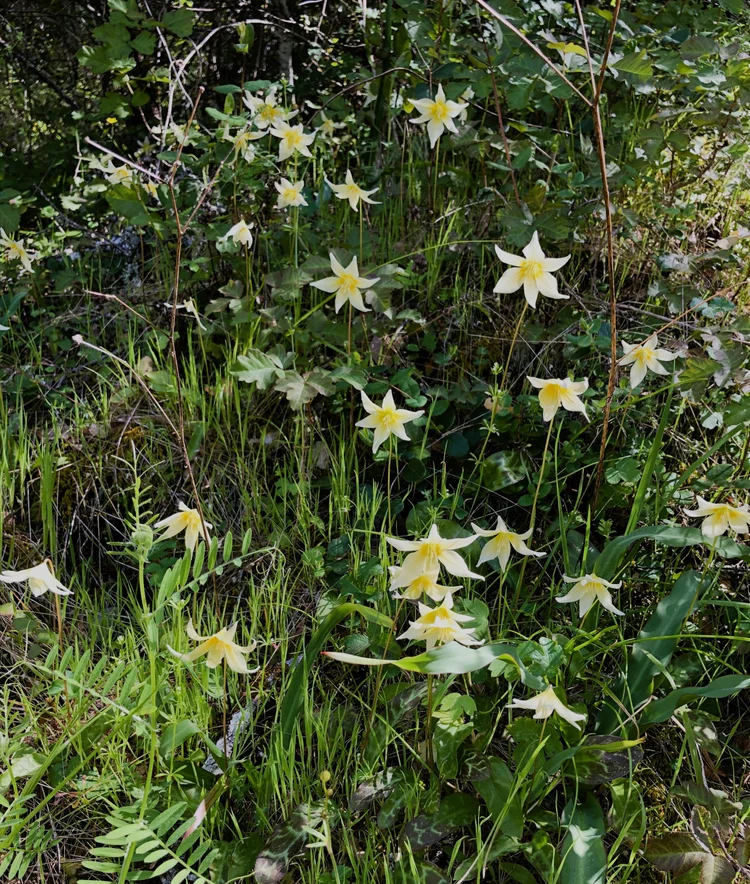
|
|
|
April 24, 2023, E. multiscapideum (Sierra fawn lily) On a trip to view the famous flower display at the North Table Mountain Ecological Reserve north of Oroville, we could not resist driving 15 miles farther north to the town of Paradise, where we knew the Sierra fawn lily could be found. It was sobering to drive through Paradise, which in 2018 had suffered one of the deadliest fires in California history. As for the fawn lilies, the trick was to look for evidence of serpentine along the roadway, as this species has a strong affinity with California’s state rock. Sure enough, when we stopped near some greenish rock outcroppings and clambered up the bank, we found lots of lilies, a little beyond their prime but spilling all over a brushy hillside that was recovering from the fire.
|
|
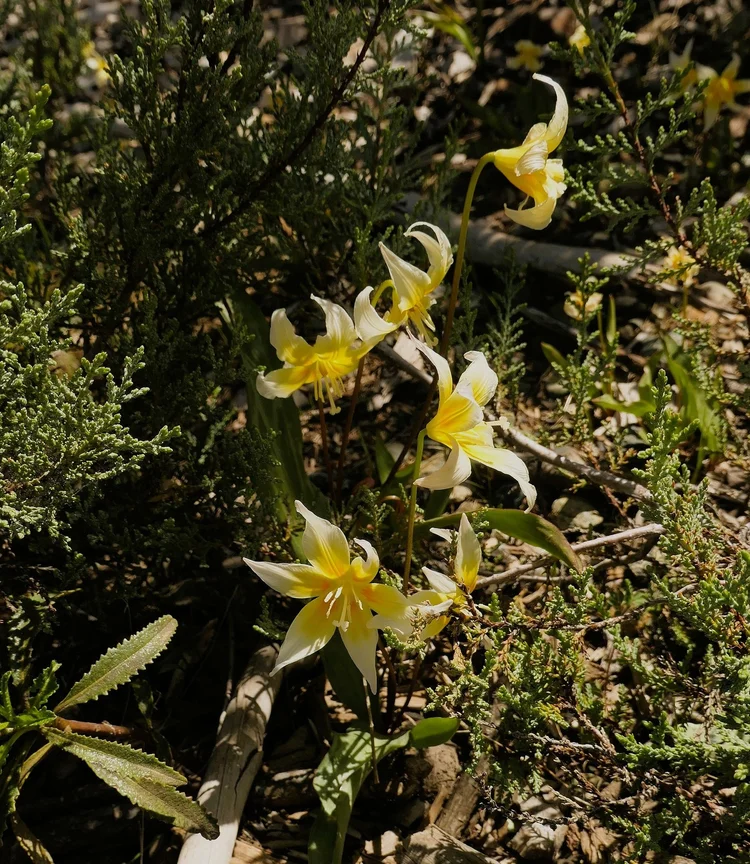
|
E. multiscapideum. Photo by Douglas Vaughan. |
|
|
|
|
April 1, 2024, E. helenae (St. Helena fawn lily) Driving north up the Napa Valley, through St. Helena, and east into the hills to the town of Angwin, we found our way to Pope Valley Road. We were unable to find the lilies that had been reported in two spots along the road, but our search led us to the historic resort of Aetna Springs, which had a charm of its own. Sitting on 670 acres with an underground hot spring, it was founded in 1877 and has long been neglected. However, some of the old buildings, built of timber and river rocks, are still standing, and in January 2023, the resort and an adjacent 3000 acres of Pope Valley land were bought by a developer who hopes to revive the old spa.
|
Aetna Springs gate. Photo by Douglas Vaughan. |
|
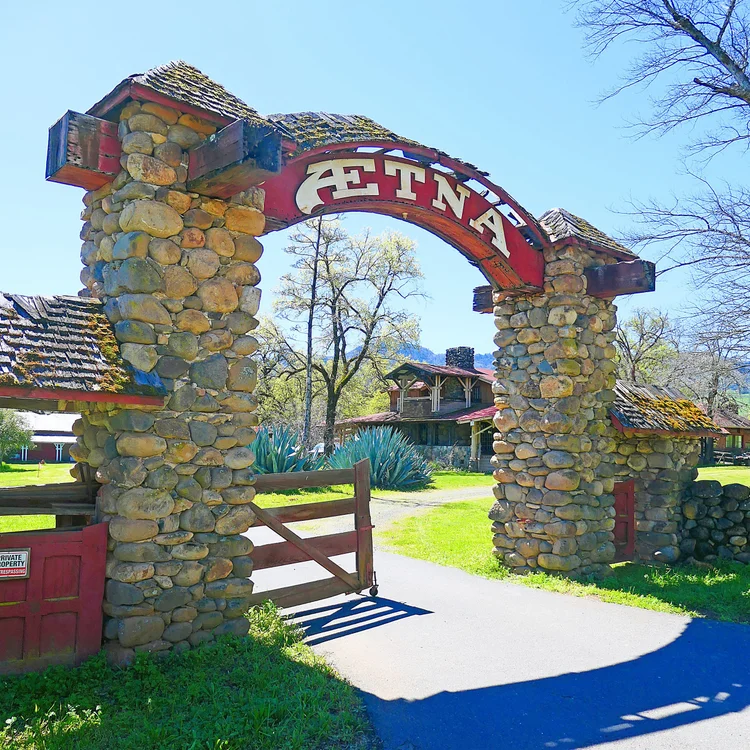
|
|
|
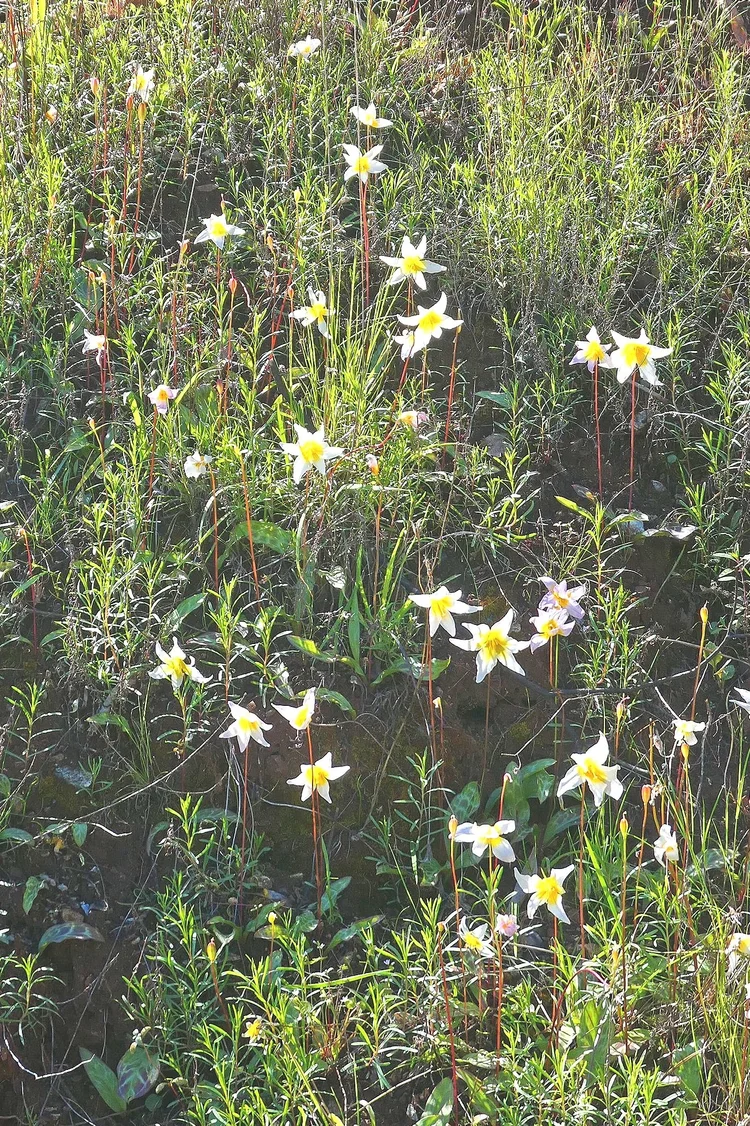
|
Luckily, we had one more spot to try as we continued driving past green fields and valley oaks up into the hills. Suddenly, after the pavement ended and the track started climbing in earnest, there they were—a beautiful stand of about of about 50 St. Helena fawn lilies on the right side of the road. E. helenae. Photo by Douglas Vaughan. |
|
|
|
April 24, 2024, E. citrinum (lemon-colored fawn lily) Finally, here is a story of the serendipity that is part of botanizing. In late April, 2024, we decided we would visit one of California’s most celebrated wildflower sites, Cook and Green Pass, which is close to the Oregon border at 4,779 feet. We knew it was too early for the E. grandiflorum that are found in the vicinity, but we wanted to revisit the pass. Heading east on Hwy 96, we stopped in the settlement of Seiad Valley, population about 350, to pick up lunch. There we were warned by a dubious resident that probably no one had been up there yet this year, there could be trees across the road, and it really seemed too early for us city slickers to be going up there. Thus primed for adventure, we headed up the narrow Seiad Creek Road. We did in fact have to move a small downed tree, but to our complete surprise, we also found a lovely stand of E. citrinum on the right bank, not far below the big waterfall along the road. Thrilled with this discovery and leery of a watery ditch crossing the road just above us, we made a vertiginous six-point turn and headed back down the mountain. The gentleman at the Seid Valley café had been correct, but we had managed to add another fawn lily to our list.
|
E. citrinum. Photo by Douglas Vaughan. |
|

|
|
|
These are stories of some of our successes. On the same trips we also visited spots where the lilies had already bloomed (E. shastense) or were still under three feet of snow (E. klamathense). Calflora reports 16 different species of Erythronium native to California. We’ve got a lot more fawn-lily adventures ahead of us. Doris Kretschmer is a member of the Botanic Garden Publication Committee.
|
Listing the Monarch as a Threatened SpeciesThe population of overwintering western monarchs dropped precipitously in 2024. After three reasonably good years in a row, with numbers exceeding 230,000 each year, the Xerces Society for Invertebrate Conservation counted a peak population of just 9,119 Monarchs this winter. In December 2024, the U.S. Fish & Wildlife Service proposed listing the Monarch as a threatened species under the federal Endangered Species Act. If the proposal is approved, Fish and Wildlife expects to add Monarchs to the threatened species list by the end of 2025. As part of this move, 4,395 acres in coastal California would also be listed as critical habitat for Monarchs.
|

|
The first step in the listing process is a 3-month period of public comment, which will end on March 12, 2025. Please do consider leaving a comment even if it is only to say you support the listing wholeheartedly. More info is on the Garden website. Left: Monarch (Danaus plexippus) by Sarab Seth. |
|
|
Garden Greeter Volunteers NeededIt is great fun to welcome our visitors as a Garden Greeter. Most of our visitors are new to the Garden and welcome a friendly face and a brief introduction. The kids love the ISpy and Treasure Hunt games we offer them. Would you like to be more involved with the Botanic Garden on weekends? Our next Garden Greeter Training will take place on April 26 and May 3 (both dates required) from 9:00 a.m. to 11:00 a.m., both days. If you would like to know more, contact the Greeter Coordinator, Holly Haugh, at greeter_coordinator@nativeplants.org. Come join our enthusiastic crew of volunteers!
|
Plant SalesThe Garden’s weekly and first Saturday plant sales will be on hiatus after the Saturday, March 1 sale to prepare for the Annual Spring Sale on Saturday, April 19. More information will be posted on the Garden website. To receive email notices of plant sales and other Garden events join our email list. |
|

|
|
|
|
You're invited to our free, docent-guided tours every weekend and on Park District holidays: Saturdays and Park District holidays at 2:00 p.m., and Sundays at 11:00 a.m. and 2:00 p.m. Meet at the Visitor Center, no need to sign up. Please remember, if it's raining, we'll have to cancel. Below are some of the current sights in the Botanic Garaden. |
|

|
Fragrant fritillary (Fritillaria liliacea). |
|
|
Wake Robin (Trillium chloropetalum) white form. |
|
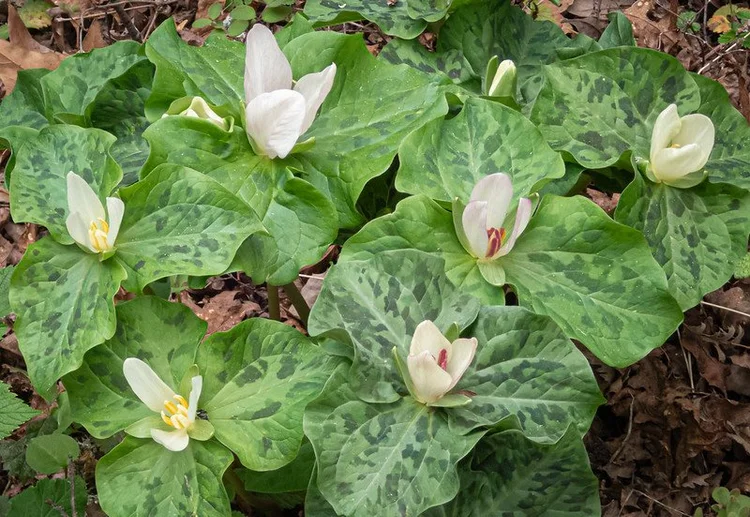
|
|
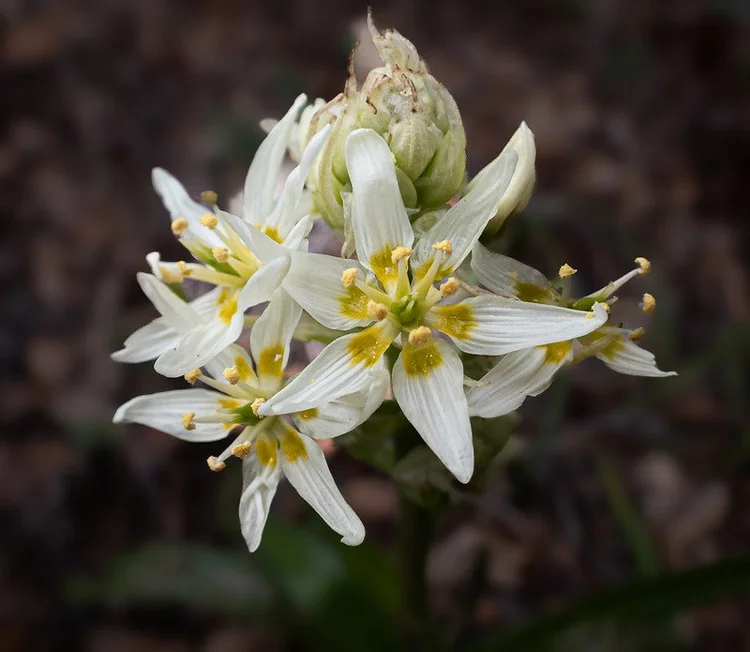
|
Death Camus or Fremont’s Star Lily (Toxicoscordion fremontii). |
|
|
Western coltsfoot (Petasites frigidus var. palmatus). Photos by Sandy Steinman. |
|
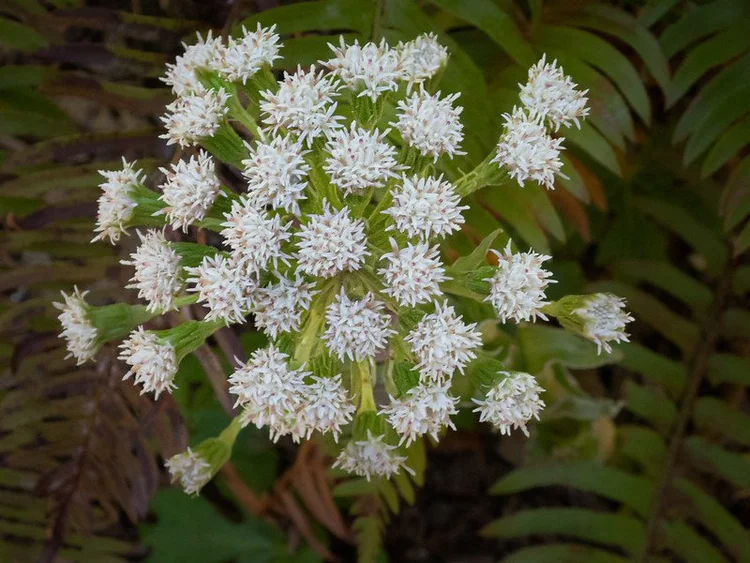
|
|
|
|
|